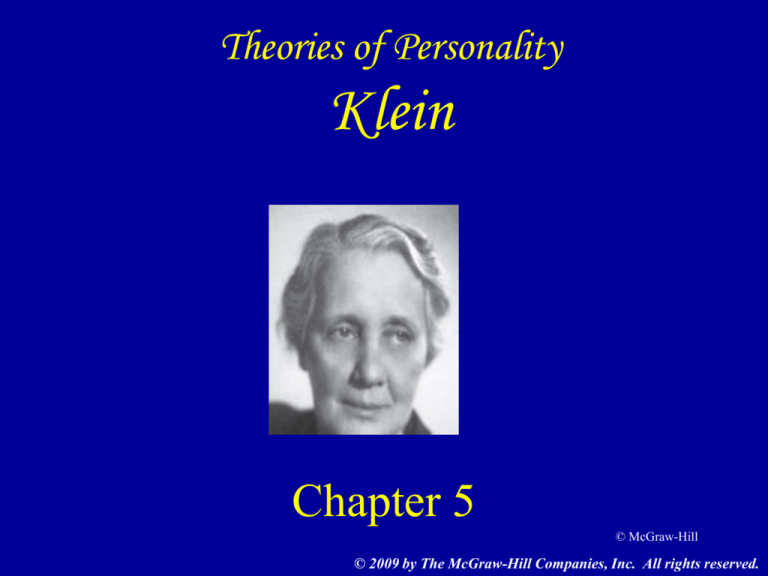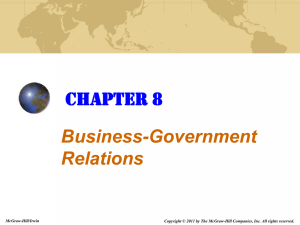
Theories of Personality
Klein
Chapter 5
© McGraw-Hill
© 2009 by The McGraw-Hill Companies, Inc. All rights reserved.
Outline
•
•
•
•
•
•
•
Overview of Object Relations Theory
Biography of Klein
Introduction to Object Relations Theory
Psychic Life of the Infant
Positions
Psychic Defense Mechanisms
Internalizations
Cont’d
© McGraw-Hill
Outline
•
•
•
•
•
Later Views on Object Relations
Psychotherapy
Related Research
Critique of Object Relations Theory
Concept of Humanity
© McGraw-Hill
Overview of Object Relations Theory
• Built on Observations of Young Children
• Infant’s Drives are Driven by Objects
– Breast is prototype for later relations
• Role of Fantasy in Interpersonal
Relationships
© McGraw-Hill
Biography of Klein
•
•
•
•
•
•
Born in Vienna in 1882
Youngest of Four Children
Complex Family Relationships
Met Sandor Ferenczi in 1909
Read On Dreams in 1914
Became an analyst by being psychoanalyzed and through a
study of psychoanalysis
• Was First in Freud’s Circle to Psychoanalyze Children
Directly
• Her The Psycho-Analysis of Children was published in
1932
• Died in England in 1960
© McGraw-Hill
Introduction to Object Relations Theory
• Related to Freud’s Instinct Theory but
Differs in Three Important Ways:
– Emphasizes consistent patterns of interpersonal
relationships
– Stresses intimacy and nurturing (maternal)
– Relatedness as prime motive of human behavior
© McGraw-Hill
Psychic Life of the Infant
• Fantasies
– Infants possess an active fantasy life
– Most basic fantasies are of what is “good” and
“bad” (e.g., good and bad breast)
• Objects
– Drives have an object
– Objects are introjected or taken into child’s
fantasy world and have a life of their own
© McGraw-Hill
Positions
• Paranoid-Schizoid Position
– Organizing experiences in way that includes
both feelings of persecution and splitting of
internal and external objects into the good and
the bad
• Depressive Position
– Anxiety over losing a loved object
– Sense of guilt for wanting to destroy loved
object
© McGraw-Hill
Psychic Defense Mechanisms
•
•
•
•
Introjection
Projection
Splitting
Projective Identification
© McGraw-Hill
Internalizations
• Aspects of the External World That
Are Organized Internally into a
Psychologically Meaningful
Framework
– Ego
– Superego
– Oedipus Complex
• Male Oedipal Complex
• Female Oedipal Complex
© McGraw-Hill
Later Views of Object Relations
•
Margaret Mahler’s View
– Observed infant/mother interaction during
the first three years of infants’ lives
– Examined change from security to
autonomy
– Children pass through a series of three
major developmental stages:
1. Normal autism (birth through 3-4 weeks)
2. Normal symbiosis (4th week-5th month)
3. Separation-individuation (5th-36th month)
© McGraw-Hill
Later Views of Object Relations
• Heinz Kohut’s View
– Emphasized the process of development of
the self
– In caring for infants’ physical and
psychological needs, adults or self-objects
treat them as if they had a sense of self
– Self is the “center of the individual’s
psychological universe”
– Early self is characterized by two
narcissistic needs:
• To exhibit the grandiose self
• To acquire an idealized image of parents
© McGraw-Hill
Later Views of Object Relations
• John Bowlby’s View
– Tried to Integrate with Evolutionary
Theory
– Childhood was the Starting Point
– By studying human and other primate
infants, he observed three stages of
separation anxiety:
• Protest, Despair, & Detachment
– Two fundamental assumptions
• Caregiver must create a secure base of child
• Bonding relationship becomes internalized
and acts as model for future relationships
© McGraw-Hill
Later Views of Object Relations
• Mary Ainsworth was influenced by
Bowlby
– Developed Strange Situation technique for
measuring attachment style
– Found three basic styles:
• Secure, Anxious-resistant, & Anxious-avoidant
© McGraw-Hill
Psychotherapy
• Klein Thought all Children Should be
Psychoanalyzed
• Substituted Play Therapy for Dream Work
• Goal of Kleinian Psychotherapy:
– To reduce depressive anxieties and persecutory
fears, and to lessen the harshness of internalized
objects
© McGraw-Hill
Related Research
• Object Relations and Eating Disorders
– Huprich et al. (2004)
• Disturbed object relations associated with eating disorders
• Attachment Theory and Adult Relationships
– Hazan & Shaver (1987)
• Those with secure attachments experience more trust, closeness, and
positive emotions in relationships
– Rholes et al. (2007)
• Avoidant individuals seek less information about their romantic
partners while anxious individuals seek more
– Davidovitz et al. (2007)
• Attachment styles and information seeking in leadership: Military
officers and their soldiers: Lower well-being in units with avoidant
officers; lower instrumental functioning, but higher socioemotional
functioning, in units with anxious officers
© McGraw-Hill
Critique of Object Relations Theory
• Attachment Theory
– High on Practicality, Internal
Consistency, and Falsifiability
– Moderate on Generating Research
– Low on Parsimony (Particularly Kleinian
Theory) and Organizing Knowledge
© McGraw-Hill
Concept of Humanity
• Determinism over Free Choice
• Equal Emphasis on Optimism and
Pessimism
• Causality over Teleology
• Unconscious over Conscious
• Social Determinants over Biology
• Similarity over Uniqueness
© McGraw-Hill






